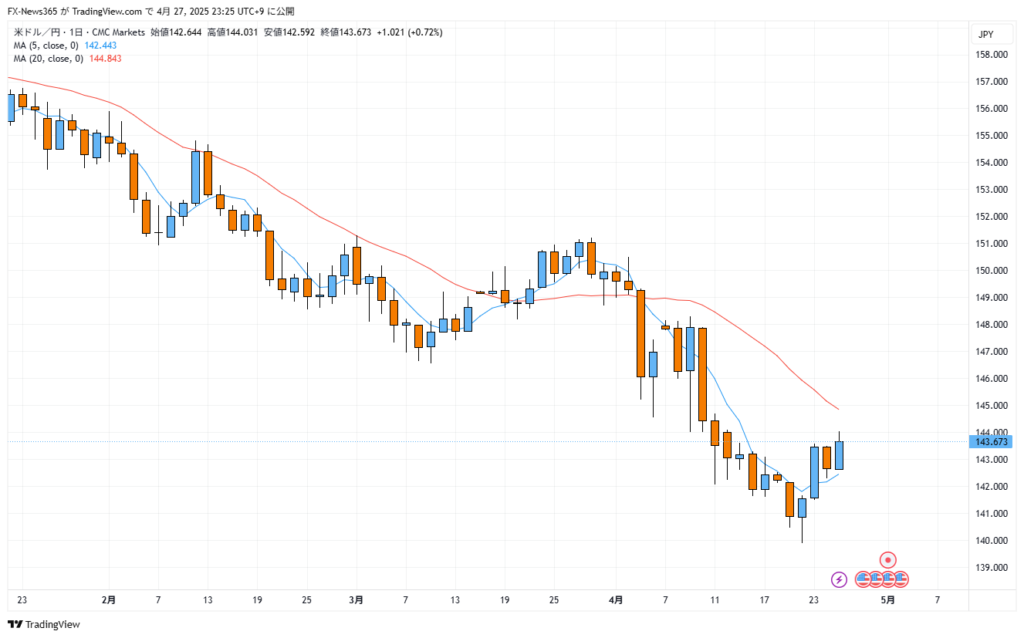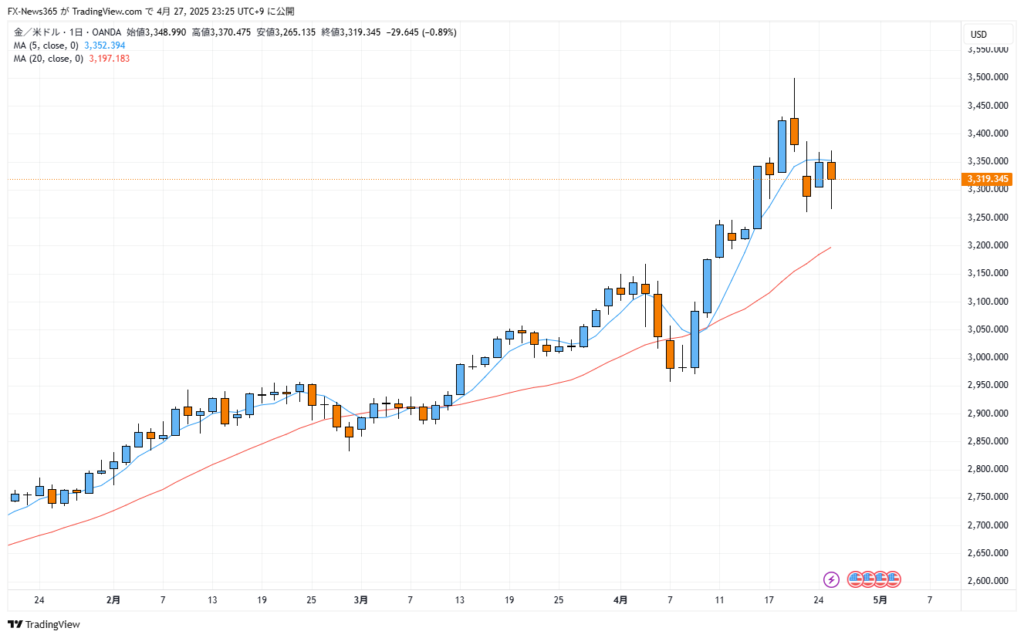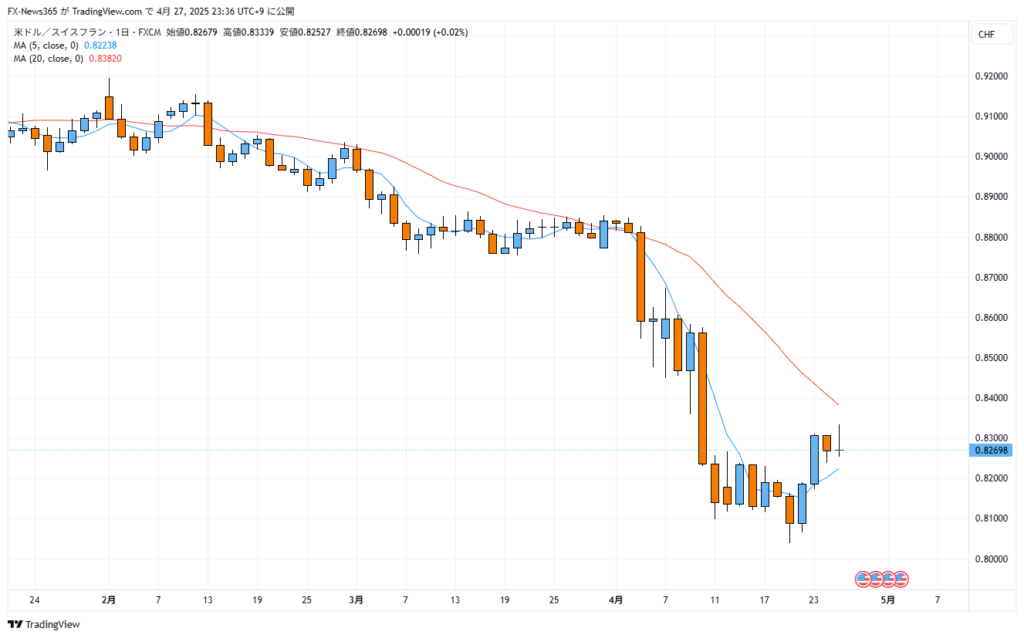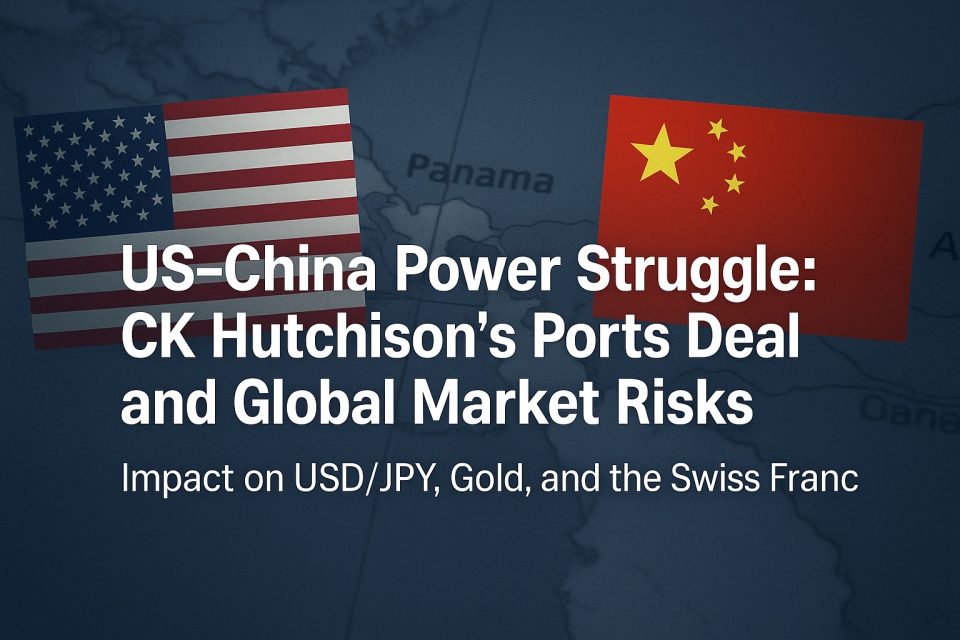What You’ll Learn in This Article
- Why CK Hutchison’s port sale became a major US-China geopolitical flashpoint
- How rising risk-off sentiment could affect USD/JPY, gold, and the Swiss franc
- Tactical trade setups and key risk zones to watch
Chapter 1: Headline News
China’s SAMR Cracks Down on CK Hutchison’s Port Sale: A Geopolitical Flashpoint
On April 27, 2025, both Reuters and Bloomberg reported that China’s top market regulator,
the State Administration for Market Regulation (SAMR), announced a strict stance regarding CK Hutchison Holdings’ proposed sale of its global ports business.
SAMR warned that no transaction would be permitted without a full antitrust review, signaling that Beijing is watching the deal closely.
The sale, led by a consortium spearheaded by BlackRock, includes 43 ports across 23 countries — notably featuring two critical ports near the Panama Canal,
a strategic trade artery vital to both China and the United States.
This development is not merely a corporate M&A matter.
With tensions escalating between Washington and Beijing, the sale of strategic global infrastructure assets has become highly politicized.
China appears determined to prevent strategic assets from falling under foreign — and particularly American — control.
Adding to the geopolitical firestorm, U.S. President Donald Trump recently declared that American military and commercial ships should be granted free passage through the Panama and Suez Canals,
arguing that the United States’ historical role in constructing these waterways justifies such demands.
In short, what initially appeared to be a routine corporate transaction is now shaping into a critical flashpoint in the ongoing US-China power struggle,
with significant potential to trigger broader market repercussions.
Chapter 2: The True Nature of the Deal
Why This Is About More Than Antitrust: Strategic Assets and Sovereignty
While on the surface this dispute revolves around antitrust procedures,
the true stakes are far more profound.
The assets in question include ports located near the Panama Canal —
a linchpin of global maritime trade and a strategic chokepoint with enormous economic and military significance.
For both China and the United States, influence over this area translates into broader leverage over global trade flows and naval mobility.
China’s aggressive regulatory stance suggests this is not merely about market competition.
It is about preserving control over strategic global infrastructure and preventing what Beijing likely perceives as a potential strategic vulnerability:
critical assets falling into the hands of U.S.-aligned entities like BlackRock.
From the U.S. perspective, the situation is equally strategic.
President Trump’s demand for free passage for American vessels through the Panama and Suez Canals underscores Washington’s intent to reassert its influence over key global trade arteries.
This signals a shift from economic rivalry to open competition for strategic assets — and ultimately, global dominance.
Thus, the CK Hutchison ports deal represents a microcosm of the broader U.S.-China power struggle:
- China seeks to defend and expand its global footprint.
- The United States seeks to reclaim lost influence and prevent Chinese dominance.
Understanding this underlying dynamic is crucial.
The market implications extend far beyond a single corporate transaction —
they touch the very foundations of global economic order and geopolitical stability.
Chapter 3: Key Currencies and Risk-Off Assets in Focus
USD/JPY, XAU/USD, USD/CHF, USD/CNY: Expected Market Reactions
The escalating tensions over CK Hutchison’s port sale are rippling beyond geopolitics into the currency and commodity markets.
Key assets particularly sensitive to risk-off sentiment are already showing signs of adjustment.
Here’s what traders should watch:
USD/JPY (US Dollar / Japanese Yen)
- Traditionally, the Japanese yen strengthens during periods of geopolitical stress as a classic safe-haven currency.
- While the US dollar can also attract safe-haven flows, the yen’s risk-off advantage tends to dominate when geopolitical risk is tied directly to US-China tensions.
- Short-term outlook:
A bias toward JPY strength (USD/JPY downside) is favored as risk sentiment deteriorates.
XAU/USD (Gold / US Dollar)
- Gold remains the ultimate safe-haven asset, benefiting whenever global uncertainty spikes.
- With strategic assets and global trade routes in play, the probability of a deeper and longer-lasting risk-off phase is increasing.
- Short-term outlook:
Any dips toward support zones are likely to be viewed as buying opportunities for gold bulls.
USD/CHF (US Dollar / Swiss Franc)
- The Swiss franc, like the yen, tends to appreciate during geopolitical turmoil.
- Although USD/CHF is attempting a short-term rebound, the broader trend remains downward as risk-off flows persist.
- Short-term outlook:
Selling rallies (USD/CHF downside bias) is preferred unless there is a major easing of tensions.
USD/CNY (US Dollar / Chinese Yuan)
- The yuan is directly tied to the heart of the geopolitical tension.
- Increased geopolitical stress typically weakens the yuan, leading to upward pressure on USD/CNY.
- However, traders must remain vigilant for intervention by Chinese authorities to stabilize the currency.
- Short-term outlook:
Expect choppy, intervention-sensitive price action, but with an underlying upside bias for USD/CNY.
Summary
✅ The CK Hutchison controversy acts as a catalyst for a broader risk-off phase, impacting key safe-haven and regional currencies alike.
✅ Traders should monitor for confirmation signals — especially in USD/JPY, XAU/USD, and USD/CHF — where technical setups align with the broader sentiment shift.
Chapter 4: Trade Setups and Caution Zones
Tactical Entry and Exit Points for Risk-Off Scenarios
Given the heightened geopolitical risks stemming from the CK Hutchison ports controversy,
the current market environment calls for tactical trading strategies focused on risk-off dynamics.
Here’s how traders can position themselves across key assets:
USD/JPY — Short the Rally

- Strategy: Look for short opportunities near the 144.50–144.80 resistance zone.
- Confirmation: Watch for bearish reversal patterns (e.g., bearish engulfing candles) near the 20-day moving average (~144.80).
- Caution Zone: If USD/JPY breaks and holds above 145.00, reconsider short setups and reassess the risk sentiment.
XAU/USD — Buy the Dip

- Strategy: Seek buying opportunities near the 3,300–3,310 support zone.
- Confirmation: A bullish reversal signal, such as a strong bullish engulfing or hammer candle, would validate entry.
- Caution Zone: If gold falls below 3,270, prepare for a deeper retracement toward the 3,250 zone.
USD/CHF — Sell on Strength

- Strategy: Look for selling opportunities around the 0.8350–0.8380 resistance area.
- Confirmation: A bearish rejection or shooting star candle around the 20-day moving average would strengthen the case for shorts.
- Caution Zone: A sustained break above 0.8430 would invalidate the bearish setup.
USD/CNY — Play the Breakout

- Strategy: Wait for a clear breakout from the current consolidation range (around 7.2950).
- Confirmation:
- Break below 7.2700: Consider short-term CNY strength (USD/CNY downside).
- Break above 7.3200: Look for renewed USD/CNY upside momentum.
- Caution Zone: Be wary of sudden, unpredictable moves caused by Chinese central bank intervention.
Summary
✅ Risk-off setups are currently favored across multiple assets, but flexibility is key as geopolitical developments unfold.
✅ Focus on clear technical confirmation at key zones to avoid getting trapped in false moves — particularly in USD/CNY where intervention risks are higher.
Chapter 5: Market Sentiment on X
How Traders and Analysts Are Interpreting the Situation
Reactions on X (formerly Twitter) to the CK Hutchison ports controversy reveal that the market is treating this not merely as a corporate deal,
but as a potential flashpoint in the ongoing US-China power struggle.
Here are the key sentiment trends emerging among traders and analysts:
Rising Anti-China Sentiment
- Many posts reflect a growing frustration toward China’s global asset strategy.
For example, @shwedman criticized China for playing the “victim card” while aggressively expanding its global influence. - The tone suggests that trust in China’s global economic intentions is eroding, fueling broader risk-off sentiment.
Geopolitical Risk on Traders’ Radar
- Analysts like @AlvaApp highlighted that this is about strategic dominance, not merely antitrust compliance.
They emphasized that Beijing’s move to scrutinize the port sale is part of a broader effort to maintain control over key global assets. - The focus on assets near the Panama Canal underscores the shift from economic competition to strategic confrontation, intensifying the perception of long-term geopolitical risk.
Concerns About Global Capital Flows
- Investors such as @007ofWallSt pointed out that cross-border infrastructure investments are increasingly exposed to political risks,
suggesting that global liquidity could tighten if major strategic deals face heightened scrutiny. - This could indirectly weigh on asset prices globally as risk appetite deteriorates.
Support for U.S. Assertiveness
- Posts like those from @dogeai_gov voiced strong support for President Trump’s position,
particularly his demand for free passage through the Panama and Suez Canals. - This support reflects growing expectations for a more assertive U.S. foreign policy stance,
which could further contribute to market volatility if new retaliatory or enforcement measures are introduced.
Summary
✅ The overall market sentiment on X reflects rising geopolitical anxiety, anti-China rhetoric, and a cautious risk-off bias.
✅ Traders are increasingly pricing in higher global uncertainty, treating the CK Hutchison deal as a broader systemic risk factor.
Chapter 6: Conclusion and What to Watch Next
Critical Triggers for Further Escalation
The CK Hutchison ports controversy highlights a deeper and growing fault line in the global order —
one where strategic infrastructure, not just trade balances, becomes the battleground for power.
Markets are no longer reacting to corporate news in isolation.
Instead, traders are rightly treating developments like this as barometers of geopolitical tension,
with direct implications for safe-haven flows and global risk appetite.
Key Takeaways:
- USD/JPY: Risk-off bias favors yen strength unless tensions ease significantly.
- XAU/USD: Gold remains a preferred hedge against geopolitical instability.
- USD/CHF: Shorting rallies remains attractive amid persistent risk aversion.
- USD/CNY: Expect choppy moves sensitive to Chinese intervention risks.
What to Watch Next:
- Further U.S. Actions:
Whether President Trump’s administration follows through on demands related to the Panama Canal and escalates strategic pressure. - Chinese Countermeasures:
Any formal blocking of the port sale or broader retaliatory moves that signal Beijing’s resolve to defend strategic assets. - Global Risk Sentiment:
Broader equity and credit market reactions, particularly in emerging markets, which are highly sensitive to shifts in U.S.-China dynamics. - Safe-Haven Demand Trends:
Watch for intensified flows into the yen, Swiss franc, and gold if tensions deepen further.
Final Thought:
The CK Hutchison deal is more than a corporate transaction.
It marks another flashpoint in a world where strategic sovereignty is becoming as critical as economic growth —
a trend that traders can no longer afford to ignore.


